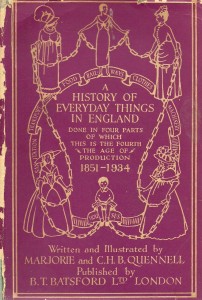Women, museums and everyday things
I was recently contacted by a PhD researcher at Cambridge, who came across Mary Greg through this very blog. Laura Carter’s research demonstrates that Mary was not alone in her interests and commitment to both the material culture of everyday life and the development of British museums during the interwar period. In fact, since starting my PhD, I have come to realise that there is a groundswell of academic interest in the active role of women in this area during the late 19th and 20th centuries, much of which has gone unrecorded for many years.
Laura’s email also contained the exciting news that Mary donated material to the Geffrye Museum in 1936. That makes a total of 30 institutions so far recorded as recipients of her generosity! Laura also offered to write something for the blog about her own research, which makes fascinating reading, especially in relation to the fuzzy boundaries between amateur and professional practice during this period. If there are other researchers out there, looking at similar material, please do get in touch.
Liz
Laura Carter
 My PhD thesis is entitled ‘Everyday life’ and ‘everyday things’ in British popular culture, c.1910-1969. It examines how people published, preserved, and sometimes sought to re-make, the ‘everyday’ past in British popular culture. One chapter focuses on the life and work of Charles (1872-1935) and Marjorie Quennell (1883-1972), in particular their series A history of everyday things in England (1918-1934), and its reception. As ‘amateur’ historians in an age of professionalization, the Quennells enjoyed much commercial success with these books. They showcased social and aesthetic history instead of the more familiar political epochs. When Charles died in 1935, Marjorie became the first female curator of the London County Council’s newly overhauled Geffrye Museum in Shoreditch.
My PhD thesis is entitled ‘Everyday life’ and ‘everyday things’ in British popular culture, c.1910-1969. It examines how people published, preserved, and sometimes sought to re-make, the ‘everyday’ past in British popular culture. One chapter focuses on the life and work of Charles (1872-1935) and Marjorie Quennell (1883-1972), in particular their series A history of everyday things in England (1918-1934), and its reception. As ‘amateur’ historians in an age of professionalization, the Quennells enjoyed much commercial success with these books. They showcased social and aesthetic history instead of the more familiar political epochs. When Charles died in 1935, Marjorie became the first female curator of the London County Council’s newly overhauled Geffrye Museum in Shoreditch.
Marjorie Quennell had an impact on the consumption of popular history in Britain in the mid-twentieth century, despite being an ‘amateur’ in all of the fields she entered. Her trajectory is worth tracing and situating. It can tell us a lot about how the notion of the ‘everyday’ found its way into British popular cultures. Marjorie’s story also highlights the centrality of women to this social turn in popular history, a point that has been understated in favour of studies of male academic popularisers.
As a young housewife in the years before the First World War, Marjorie Quennell was exposed to Arts and Crafts influences through her husband’s involvement in the Junior Art Workers Guild. In the 1920s and early 1930s, Marjorie assisted her husband in creating their famous books, which successfully repackaged Ruskinian and Morrisite ideas of the ‘everyday’ into a more demotic format. By the late 1930s, she carried these intellectual influences into the centre of a burgeoning museums movement.
At the Geffrye, Marjorie was able to realize narratives of the ‘everyday’ in practical forms – through enlarging the museums collection of bygones and furniture (including around 100 objects donated by Mary Greg 1936-7), arranging the exhibits into domestic interiors, and by initiating a highly progressive museum education programme that involved the impoverished children of Shoreditch in their labour heritage. In this context, ‘everyday life’ came to be physically and experientially reconstructed for wholly democratic purposes. Marjorie remained at the Geffrye until late 1939, when ill health forced her to retire. In 1940 she boarded the last passenger boat to America, as her doctor had advised her that her delicate health would not withstand the bombing.
The Geffrye Museum has a forthcoming small display celebrating the museum’s centenary, opening on 1 July 2014, which will recognise Marjorie’s transformation of and contribution to the museum, and display some of the objects Mary donated to the museum during Marjorie’s tenure.

No, Laura has been through the archives and there is nothing. I’ve been through family documents in Hertfordshire but they stop in 1927 when Mary left Coles. Shame! It does suggest though that there may be more to find as the other small donations we know about all date from around 1925-7 when she was clearing the house. It is exciting, isn’t it!
Wow – this is so exciting – must go and see this exhibition at the Geffrey, and fascinating to read about Laura’s research.
So Mary must have known (and corresponded with?) Marjorie – I wonder if any of the letters remain in the archive?